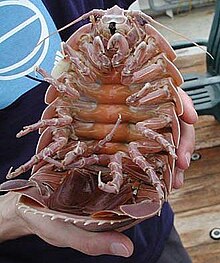Bathynomus giganteus
| Bathynomus giganteus | |
|---|---|

| |
| The underside of Bathynomus giganteus | |
| Scientific classification | |
| Domain: | Eukaryota |
| Kingdom: | Animalia |
| Phylum: | Arthropoda |
| Class: | Malacostraca |
| Superorder: | Peracarida |
| Order: | Isopoda |
| Family: | Cirolanidae |
| Genus: | Bathynomus |
| Species: | B. giganteus
|
| Binomial name | |
| Bathynomus giganteus A. Milne-Edwards, 1879
| |
Bathynomus giganteus is a species of aquatic crustacean, of the order Isopoda. It is a member of the giant isopods (Bathynomus), and as such it is related—albeit distantly—to shrimps and crabs.[2] It was the first Bathynomus species ever documented and was described in 1879 by French zoologist Alphonse Milne Edwards after the isopod was found in fishermen's nets off the coast of the Dry Tortugas in the Gulf of Mexico.[3]
The Bathynomus is benthic and abundant in cold waters with a depth of 310–2140 m in the West-Atlantic, including the Gulf of Mexico and the Caribbean. It was the first species of Bathynomus to be described and historically it was reported from other oceans, but these are now recognized as other closely related species.[4][5] The unusually large size of Bathynomus has been attributed to an effect called deep-sea gigantism, where invertebrates living in cold deep waters tend to grow larger and have longer lifespans.[6][7]
Physical description[edit]

Like most crustaceans, the body of Bathynomus giganteus is divided into three distinct regions; a head (cephalon), a thorax, and an abdomen (pleon).[3] They have large triangular compound eyes that are spaced very far apart and have over 4000 individual facets.[8] When light bounces off a highly-reflective layer called the tapetum lucidum at the back of their eyes, it makes them appear to glow.[8] B. giganteus reaches a typical length between 19 and 36 cm[9] an individual claimed to be 76 cm long has been reported by the popular press, but the largest confirmed was ca. 50 cm.[10]
Reproduction[edit]
Bathynomus reproduce via egg-laying. Mature females develop a pouch known as a marsupium, where the eggs are stored until the young are ready to emerge as miniatures of the adults, known as manca, completely bypassing a larval stage.[11] Mancas can reach lengths up to 60 mm and are characterized by their lack of the seventh pair of pereiopods.[3] The reproductive anatomy of Bathynomus giganteus resembles that of other isopods.[12] The females of B. giganteus, while being so many times larger than females of other isopods, carries approximately the same number of eggs in its marsupium.[12] The eggs, however, show an increase in size which appears to be almost proportional to the increase in body size.[12] The reproductive organs of the males also resemble those of the males of smaller isopod species.[12]
Aquaculture[edit]
Giant isopods are not usually fished commercially. However, other Bathynomus species can be found in the occasional oceanside restaurant in northern Taiwan, where they are boiled and typically served with rice.[2]
References[edit]
- ^ "WoRMS - World Register of Marine Species - Bathynomus giganteus A. Milne-Edwards, 1879".
- ^ a b "Giant Isopod | Bathynomus giganteus | SeaPics.com". seapics.com. Retrieved 17 January 2019.
- ^ a b c Briones-Fourzán, Patricia; Lozano-Alvarez, Enrique (1 July 1991). "Aspects of the biology of the giant isopod Bathynomus giganteus A. Milne Edwards, 1879 (Flabellifera: Cirolanidae), off the Yucatan Peninsula". Journal of Crustacean Biology. 11 (3): 375–385. doi:10.2307/1548464. JSTOR 1548464.
- ^ Lowry, J. K.; Dempsey, K. (2006). "The giant deep-sea scavenger genus Bathynomus (Crustacea, Isopoda, Cirolanidae) in the Indo-West Pacific". In Richer de Forges, B.; Justone, J.-L. (eds.). Tropical Deep-Sea Benthos. Vol. 24. Mémoires du Muséum national d'Histoire naturelle. pp. 163–193.
- ^ Shipley, O.; Bruce, N. L.; Violich, M.; Baco, A.; Rawlins, S.; Brooks, E. J. (2016). "A new species of Bathynomus Milne Edwards, 1879 (Isopoda: Cirolanidae) from The Bahamas, Western Atlantic". Zootaxa. 4147 (1): 82–88. doi:10.11646/zootaxa.4147.1.6. PMID 27515606.
- ^ McClain, C. R. (4 April 2007). "Why is The Giant Isopod Giant? | ScienceBlogs". scienceblogs.com. Retrieved 17 January 2019.
- ^ Timofeev, S. F. (November 2001). "Bergmann's Principle and Deep-Water Gigantism in Marine Crustaceans". Izvestiia Akademii Nauk. Seriia Biologicheskaia. 28 (6): 764–768.
- ^ a b Chamberlain, Steven; Meyer-Rochow, Victor (1986). "Morphology of the compound eye of the giant deep-sea isopod Bathynomus giganteus". Journal of Morphology. 189 (2): 145–156. doi:10.1002/jmor.1051890205. PMID 3746916. S2CID 37070286.
- ^ Briones-Fourzán, Patricia; Lozano-Alvarez, Enrique (1 July 1991). "Aspects of the biology of the giant isopod Bathynomus giganteus A. Milne Edwards, 1879 (Flabellifera: Cirolanidae), off the Yucatan Peninsula". Journal of Crustacean Biology. 11 (3): 375–385. doi:10.2307/1548464. JSTOR 1548464.
- ^ McClain, Craig R.; Balk, Meghan A.; Benfield, Mark C.; Branch, Trevor A.; Chen, Catherine; Cosgrove, James; Dove, Alistair D.M.; Gaskins, Lindsay C.; Helm, Rebecca R.; Hochberg, Frederick G.; Lee, Frank B.; Marshall, Andrea; McMurray, Steven E.; Schanche, Caroline; Stone, Shane N.; Thaler, Andrew D. (13 January 2015). "Sizing ocean giants: patterns of intraspecific size variation in marine megafauna". PeerJ. 3: e715. doi:10.7717/peerj.715. PMC 4304853. PMID 25649000.
- ^ Ax, Peter (28 August 2000). Multicellular Animals: The Phylogenetic System of the Metazoa. Springer Science & Business Media. ISBN 9783540674061.
- ^ a b c d Perry, Noretta; Hinsch, Gertrude (1991). "Reproduction in the giant isopod, Bathynomus giganteus". Invertebrate Reproduction & Development. 20 (2): 153–157. doi:10.1080/07924259.1991.9672192.
